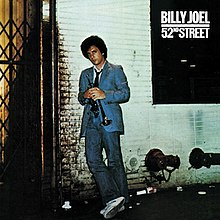| 52nd Street | ||||
|---|---|---|---|---|
 | ||||
| Studio album by | ||||
| Released | October 11, 1978 | |||
| Recorded | July–August 1978 | |||
| Studio | A & R, New York City | |||
| Genre | ||||
| Length | 40:26 | |||
| Label | Family Productions/Columbia | |||
| Producer | Phil Ramone | |||
| Billy Joel chronology | ||||
| ||||
| Singles from 52nd Street | ||||
| ||||
52nd Street is the sixth studio album by American singer-songwriter Billy Joel, released on October 11, 1978, by Columbia Records.[2] Presenting itself as the follow-up to his breakthrough studio album, The Stranger, Joel tried to give the new album a fresh sound, hiring various jazz musicians to differentiate it from his previous studio albums.[3]
The album's title is a reference to 52nd Street, a popular street location in Midtown Manhattan for jazz musicians, beginning during the Great Depression and continuing through to the 1950s. Joel's label was headquartered within the CBS Building on West 52nd Street at the time of the album's release. The studio where recording took place was also on 52nd Street, one block away from where Joel's label was headquartered.[citation needed]
52nd Street was an instant commercial success, becoming Joel's first album to reach number one on the Billboard 200, a spot it held for eight consecutive weeks. Three songs reached the Top 40 in the United States, contributing to the album's success: "My Life" (number 3), "Big Shot" (number 14), and "Honesty" (number 24).[4] It was similarly well received by critics, earning two Grammy awards for Best Male Pop Vocal Performance and Album of the Year at the 22nd Annual Grammy Awards.[5] The latter Grammy was presented to its producer, Phil Ramone. Upon Ramone's death, 52nd Street's Album of the Year Grammy was passed on to Joel.
The album was among the first commercially released on the compact disc format, reaching store shelves on October 1, 1982, in Japan (it was one of 50 CDs released that day, including The Stranger, but bore the first catalogue number in the sequence, 35DP-1, and so is frequently cited as the first to be released).[6] In keeping with this history, it was also the first release when Sony returned to manufacturing vinyl records in 2018.[7]
- ^ Strong, Martin Charles (1995). Great Rock Discography. Canongate Press. p. 436. ISBN 978-0-86241-541-9.
- ^ RIAA lists October 11 as the release date. Billy Joel tweeted that it was October 12.
- "Billy Joel – 52nd Street". Gold and Platinum Certification. RIAA. 2020. Retrieved July 3, 2020.
- @billyjoel (October 12, 2019). "52nd St Release Date" (Tweet). Retrieved October 12, 2019 – via Twitter.
- ^ "Remember When? Billy Joel's '52nd Street'". GRAMMY.com. October 13, 2017. Retrieved September 29, 2021.
- ^ "allmusic ((( 52nd Street > Charts & Awards > Billboard Singles )))". allmusic.com. Retrieved October 3, 2011.
- ^ "Past Winners Search". grammy.com. Archived from the original on August 1, 2013. Retrieved October 3, 2011.
- ^ "How Billy Joel's '52nd Street' Became the First Compact Disc Released". Ultimate Classic Rock. October 2012. Archived from the original on July 6, 2017.
- ^ "Sony joins vinyl revival with first LP releases in almost 30 years". Archived from the original on September 29, 2018. Retrieved September 29, 2018.